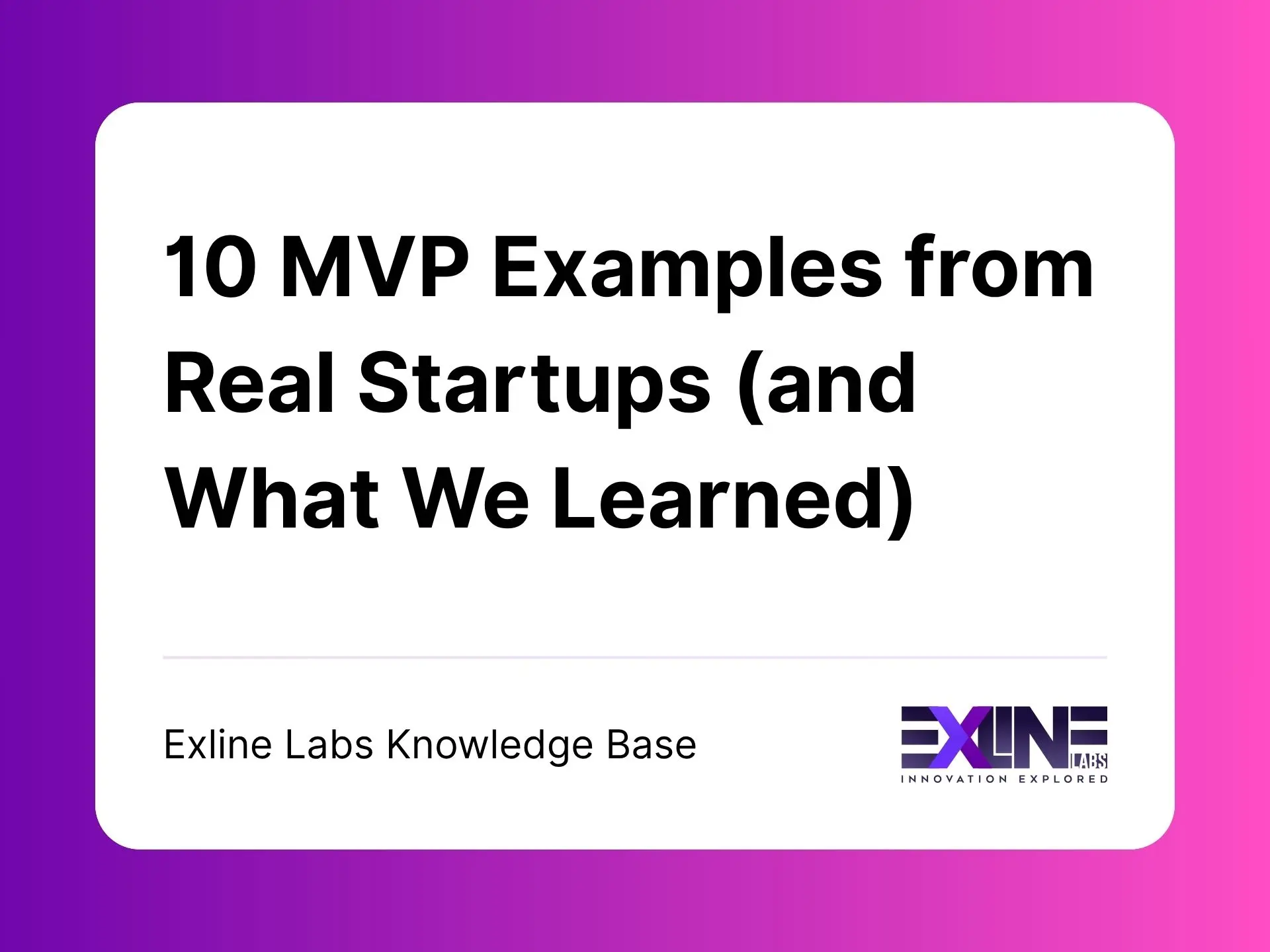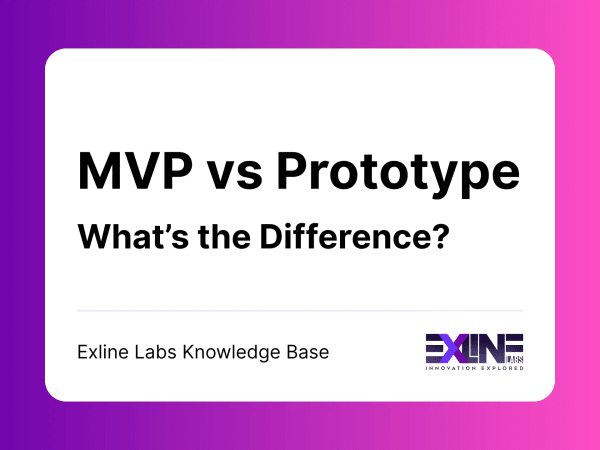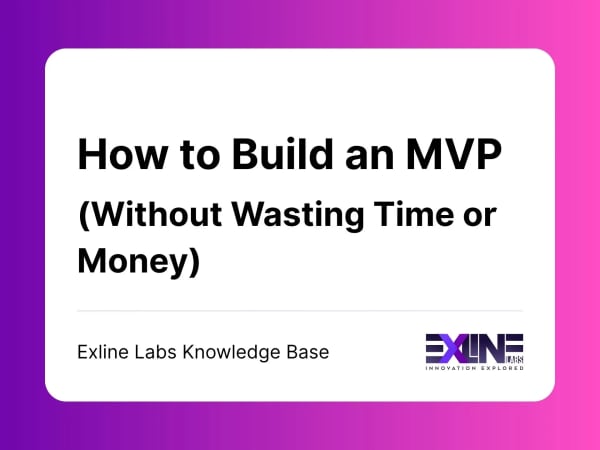10 MVP Examples from Real Startups (and What We Learned)

In this article, we showcase 10 real-world MVP examples across industries and funding stages, along with practical takeaways you can apply to your own product journey.
Date Published
20 Nov 2025
Date Updated
20 Nov 2025
Written By
Exline Labs Team
Reading Time
4 min read
Service Type
MVP DevelopmentIntroduction
One of the best ways to learn how to build your MVP? Study what other startups did and what worked, what didn’t, and how they evolved.
In this article, we showcase 10 real-world MVP examples across industries and funding stages, along with practical takeaways you can apply to your own product journey.
1. Airbnb – No Code, Just Hustle
MVP Format: Simple website + photos + email
What they did: The founders rented out their own apartment and built a basic landing page to test demand for short-term rentals.
Lesson: Start with a manual version of your product and test demand before scaling tech.
2. Dropbox – Demo Video Validation
MVP Format: 2-minute explainer video
What they did: Instead of building complex syncing tech upfront, Dropbox created a video to show the concept, and signed up 70,000+ users.
Lesson: You can validate ideas with content, and not just code.
3. Slack – Internal Tool First
MVP Format: Internal chat system
What they did: Slack started as an internal communication tool for a failed game. They repurposed it, refined it, and released it to other teams.
Lesson: Solve your own problem first, and then productize it.
4. Zappos – Concierge MVP
MVP Format: Manual backend
What they did: The founder listed shoe photos online, then bought each pair manually from a store after receiving an order.
Lesson: You can fake automation to test demand. Focus on proof of concept, not scalability.
5. Buffer – MVP with Just a Form
MVP Format: Landing page + email form
What they did: Buffer launched a simple page explaining the value, and measured clicks and signups before building anything.
Lesson: Use a landing page to validate interest before writing a line of code.
6. Uber – One City, One Use Case
MVP Format: Black car bookings in San Francisco
What they did: Uber started with just luxury rides in one city, with limited payment options.
Lesson: Stay hyper-focused on a small audience before expanding.
7. Product Hunt – Email Newsletter
MVP Format: Curated daily email
What they did: The founder began by emailing a list of new product links to friends and followers.
Lesson: Email is a great way to test community-based products.
8. Tinder – Campus-Only Beta
MVP Format: Simple swiping app for USC students
What they did: Tinder launched only at one university to test their swipe UX and social dynamics.
Lesson: Closed betas give better signal and reduce risk.
9. Etsy – Powering a Niche Audience
MVP Format: Marketplace for crafters from forums
What they did: Etsy connected with the craft community from forums, giving them a better way to sell their products.
Lesson: Start with a passionate, underserved niche — then build out.
10. ChatGPT Plugins (OpenAI) – Manual Waitlist Flow
MVP Format: Curated access, manual onboarding
What they did: OpenAI launched plugin support slowly, validating the need and complexity through manual testing.
Lesson: Even large AI companies validate in small steps.
What These MVPs Have in Common
· Each solved one core problem
· Each launched quickly
· None were “perfect”, but they worked
· All iterated based on early feedback
Key Takeaways for Your MVP
Understanding what is an MVP helps you focus on validation, not perfection, build only what you need to learn fast.
· Validate before you scale
· Use simple tools (not full builds)
· Talk to users constantly
· Build just enough to test one thing
“If you're not embarrassed by your first version, you launched too late.” - Reid Hoffman, LinkedIn.
Have any Questions?
What is a real-life example of a successful MVP?
Dropbox started with a simple explainer video demonstrating how the product would work and before writing a single line of code.
How did Airbnb use an MVP to validate their idea?
They launched a basic website offering their own apartment for short-term rent to test if people would pay to stay in strangers' homes.
Are MVPs only for tech startups?
No. MVPs can be used for SaaS, marketplaces, mobile apps, and even service-based businesses.
How did Buffer test their MVP?
They created a landing page explaining the product and asking users to sign up and then used responses to validate interest.
Can an MVP be just a landing page?
Yes, if it tests user interest or collects emails, this is often called a "smoke test" MVP.
What was Twitter’s MVP?
Twitter started as an internal SMS service for a podcasting company and evolved based on user feedback.
Did Uber launch with a full-featured app?
No. Uber’s MVP only worked in San Francisco and allowed users to request black cars via SMS.
Why is it important to study MVP examples?
They help founders understand how to validate ideas creatively and avoid overbuilding too early.
What should I learn from failed MVPs?
That scope, timing, and solving a real problem are critical to success and many failed MVPs ignored user feedback or tried to build too much.
Can Exline Labs help build MVPs like these?
Yes, we specialize in lean MVP development for startups across the UK and EU, using proven validation frameworks.


